Star Wars has revealed the Jedi's greatest defeat before the prequel trilogy. For a thousand years, the Jedi served as protectors of the Galactic Republic. The time of the Jedi ultimately came to an end because of the Sith, with Palpatine maneuvering himself into a position of political power and orchestrating the Clone Wars as the ultimate Jedi trap. The Clone Wars were the revenge of the Sith, culminating in Order 66, when an inhibitor chip implanted within every clone trooper in the Grand Army of the Republic caused them to turn on the Jedi. However, even before this catastrophic defeat, the Jedi still suffered their share of setbacks.
Luke Skywalker was encouraged to have a romantic view of the history of the Jedi. Obi-Wan Kenobi presented a broad-brush history, describing the Jedi as peacekeepers and guardians, portraying the time before the Empire as one of peace and justice. He was, of course, oversimplifying; it's long been clear the Jedi were involved in countless conflicts of varying scale over the millennia, and the story of their greatest defeat before the prequels is being told in Lucasfilm's Star Wars: The High Republic transmedia initiative - 200 years before Star Wars: Episode I - The Phantom Menace.
The High Republic Era was a time when the Republic and the Jedi were at their height, expanding into the Unknown Regions - and inevitably finding conflict there, when they stumbled upon a warlike band of space pirates called the Nihil. In Claudia Gray's novel The Fallen Star, the Nihil launch a concerted attack on the Jedi space station Starlight Beacon. They distract the Jedi by striking across the Outer Rim, leaving the Jedi responding - and refugees flocking to Starlight Beacon, a perfect opportunity for a team of saboteurs to infiltrate. Worse still, the Nihil successful acquire mysterious creatures they call "Levelers," Force predators that distort the Force around them; they manage to bring seven Levelers aboard Starlight Beacon, leaving the remaining Jedi there reeling as the Force around them sickens and they lose its guidance. Finally, everything culminates in a horrific act of sabotage that brings down Starlight Beacon, with high-profile Jedi killed and both the Republic and its Jedi suffering a terrible defeat.
There's a striking contrast between Charles Soule's Light of the Jedi - which launched the Star Wars: The High Republic initiative - and Claudia Gray's The Fallen Star. Both feature terrible disasters caused by the Nihil, but in the former the Jedi are on hand to render aid, whereas in the latter the Jedi are themselves forced to call for help. That, more than anything else, is what makes the fall of Starlight Beacon so catastrophic - a blow to the Republic's very sense of security, while the experience of those who survived the Nihil attack will leave the Jedi's trust in the Force itself shaken. This, clearly, is the event that marks the beginning of the end of the High Republic Era - with the Sith taking advantage of the weakened Republic and Jedi.
It's likely the Sith learned many lessons from the Nihil, because there are distinct parallels between their strategies. Like the Nihil, Palpatine drew the Jedi into conflicts far from the Galactic Core, and he learned how to take advantage of their very dependence on the Force. The key difference, however, is that the Nihil's power base is indeed in the Outer Rim, whereas Darth Sidious deliberately established his in the Core. Palpatine's Clone Wars were nothing more than a distraction, a way of occupying the Jedi and dulling their connection to the Force, while he worked in secret to become Chancellor of the Republic and undermine the Jedi in the Core, taking advantage of the secrecy of the Sith. The contrasts between the Nihil and the Sith are striking, showing just why this is a Star Wars story very much worth telling.



